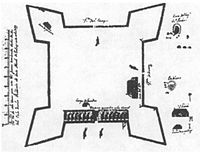Siege of Pensacola (1707)
| Siege of Pensacola | |||||||
|---|---|---|---|---|---|---|---|
| Part of Queen Anne's War | |||||||
 Fort San Carlos de Austria, map from 1699 |
|||||||
|
|||||||
| Belligerents | |||||||
|
|
Creek |
||||||
| Commanders and leaders | |||||||
| Don Sebastián de Moscoso | Unknown; second siege may have been led by Thomas Nairne | ||||||
| Strength | |||||||
| First siege: unknown, under 220 Second siege: about 300 |
First siege: several hundred Second siege: about 320 |
||||||
The Siege of Pensacola was two separate attempts in 1707 by English-supported Creek Indians to capture the town and fortress of Pensacola, then one of two major settlements (the other was St. Augustine) in Spanish Florida. The attacks, part of Queen Anne's War (the North American theater of the War of the Spanish Succession), resulted in the burning of the town, and caused most of its Indian population to flee, although the fort withstood repeated attacks.
The first siege, in August 1707, resulted in the destruction of the town, but Fort San Carlos de Austria successfully resisted the onslaught. In late November 1707 a second expedition arrived, and made unsuccessful attacks on three consecutive nights before withdrawing. Pensacola Governor Don Sebastián de Moscoso, whose garrison was depleted by disease, recruited convicted criminals to assist in the fort's defense.
English and Spanish colonization efforts in southeastern North America began coming into conflict as early as the middle of the 17th century. The Spanish population of Florida at the time was fairly small. Since its founding in the 16th century, the Spanish had set up a network of missions whose primary purpose was to pacify the local Indian population and convert them to Roman Catholicism. The founding in 1670 by the English of Charles Town (present-day Charleston, South Carolina) in the recently established (1663) Province of Carolina heightened tensions. By the early 18th century Carolina traders like Anthony Dodsworth and Thomas Nairne had established alliances with Creek Indians in the upper watersheds of rivers draining into the Gulf of Mexico, who they supplied with arms and purchased slaves and animal pelts from. These traders penetrated into Spanish Florida, leading to raiding and reprisal expeditions on both sides.
...
Wikipedia
